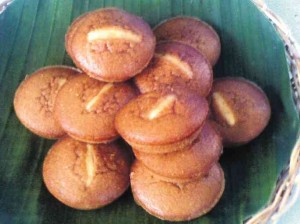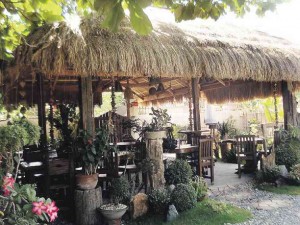CALASIAO, Pangasinan, Philippines—Just when people thought they had tasted the best of Calasiao’s puto (rice cake), a new restaurant comes up with a twist to this old favorite: Palm sugar-sweetened puto.
The palm sugar makes the puto-silag golden brown, far from the appearance of the traditional white, bite-sized puto made of rice flour and white sugar. This variety is made from cake flour, added with milk and butter for a creamier flavor and topped with cheese.
Puto-silag has become one of the best sellers of Medarlo’s Garden Grill, a restaurant set in a garden in Barangay Ambonao in this central Pangasinan town, says its owner Medarlo Barongan, a pharmacy and nursing graduate.
Barongan, 49, says the one-hectare garden-resto is still a work in progress, but it has attracted regular customers who come not only for its puto but other Filipino food with a twist as well.
Tweaking Filipino dishes
Barongan, who spent six years as a nursing assistant in the United States, says he has a passion for food and loves tweaking traditional Filipino dishes.
“I abide by Hippocrates’ saying on letting your food be your medicine, and your medicine be your food. So I try to make the dishes healthier,” he says.
Barongan earned his pharmacy degree from the University of Sto. Tomas and just graduated from nursing at Dagupan Colleges Foundation.

THE BREAKFAST and ‘merienda’ fare has been sweetened with palm sugar sourced from the village of Calasiao. Photos by Yolanda Sotelo, Inquirer Northern Luzon
His customers keep coming back for the restaurant’s steamed beef “tapa” (thinly sliced marinated beef). Unlike other tapa, the meat is marinated overnight and steamed for more than an hour using the marinade that makes the meat soft and tasty.
The restaurant also sells ready-to-fry tapa. “Since it is steamed, it does not need plenty of cooking oil, and it cooks fast,” he says.
A pack sells for P370; half-pack, P185; and one-fourth pack, P100.
Healthier versions
Barongan is proud that his restaurant offers healthier versions of perennial favorites, such as “sisig,” “bulalo,” “laing,” pork barbecue and “bopis.”
Aside from the food, the restaurant’s attraction is the place itself. Located along the Tebeng River, it is set among trees and flowering plants. The main building, surrounded by plants, is made of hardwood and roofed with thatched cogon grasses.
The tables are made from tree trunks and their matching chairs are in antique finish.
Diners can use two nipa huts for privacy. One is found on the river bank surrounded by nipa trees that produce the vinegar used in the kitchen.
The river may not be in a pristine state, but it affords diners a view of different birds and ducks frolicking in the water.
Nature atmosphere
“We offer a relaxing atmosphere,” says Marjomel Barongan, the owner’s nephew who serves as the restaurant’s marketing officer.
“In the morning, the air is really fresh and you’ll hear the birds chirping. Many times, owls are seen perched on the trees. Even at noon, the air is cool and the verdant surrounding is so calming,” Marjomel says.
Barongan says the restaurant is an accidental venture.
When he returned to the country in 2005, he stayed in a two-bedroom bahay kubo (nipa hut) that was used by his parents as a rest house before they left for the United States.
At that time, he was suffering from pain in his shoulders and a mentor in the massage therapy course he took in the United States recommended doing “chores on the soil.”
“So I began planting around the house and the pain went away. Soon, my classmates at the nursing school came for visits and we cooked and ate at the kubo. They said, ‘Why not start a restaurant here? I thought, ‘Why not?’” Barongan says.
“Cooking is my passion. I studied gourmet cooking in a night school in the United States. Even before that, I already had a business in Metro Manila which produced native candies,” he says.
In October last year, he opened his garden restaurant to combine his passion in cooking and his love for plants.


